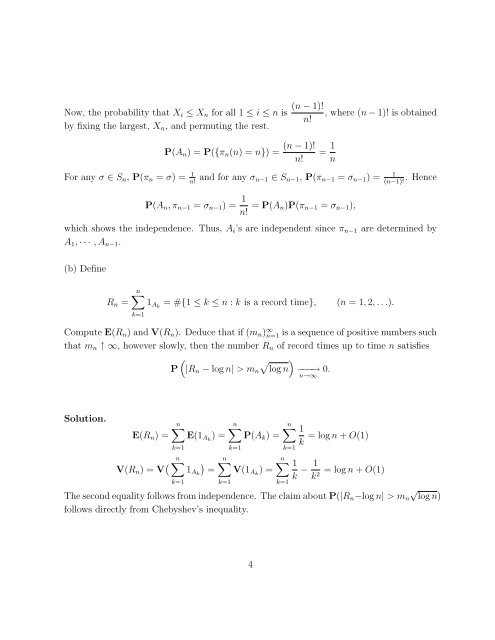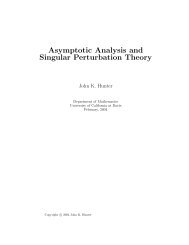Solutions to Homework Set No. 4 – Probability Theory (235A), Fall ...
Solutions to Homework Set No. 4 – Probability Theory (235A), Fall ...
Solutions to Homework Set No. 4 – Probability Theory (235A), Fall ...
You also want an ePaper? Increase the reach of your titles
YUMPU automatically turns print PDFs into web optimized ePapers that Google loves.
<strong>No</strong>w, the probability that Xi ≤ Xn for all 1 ≤ i ≤ n is<br />
by fixing the largest, Xn, and permuting the rest.<br />
P(An) = P({πn(n) = n}) =<br />
(n − 1)!<br />
, where (n − 1)! is obtained<br />
n!<br />
(n − 1)!<br />
n!<br />
For any σ ∈ Sn, P(πn = σ) = 1<br />
n! and for any σn−1 ∈ Sn−1, P(πn−1 = σn−1) = 1 . Hence<br />
(n−1)!<br />
= 1<br />
n<br />
P(An, πn−1 = σn−1) = 1<br />
n! = P(An)P(πn−1 = σn−1),<br />
which shows the independence. Thus, Ai’s are independent since πn−1 are determined by<br />
A1, · · · , An−1.<br />
(b) Define<br />
Rn =<br />
n<br />
k=1<br />
1Ak<br />
= #{1 ≤ k ≤ n : k is a record time}, (n = 1, 2, . . .).<br />
Compute E(Rn) and V(Rn). Deduce that if (mn) ∞ n=1 is a sequence of positive numbers such<br />
that mn ↑ ∞, however slowly, then the number Rn of record times up <strong>to</strong> time n satisfies<br />
<br />
<br />
P |Rn − log n| > mn log n −−−→<br />
n→∞ 0.<br />
Solution.<br />
E(Rn) =<br />
n<br />
k=1<br />
V(Rn) = V n <br />
k=1<br />
E(1Ak ) =<br />
1Ak<br />
=<br />
n<br />
k=1<br />
n<br />
P(Ak) =<br />
k=1<br />
V(1Ak ) =<br />
n<br />
k=1<br />
n<br />
k=1<br />
1<br />
k<br />
1<br />
k<br />
= log n + O(1)<br />
1<br />
− = log n + O(1)<br />
k2 √<br />
The second equality follows from independence. The claim about P(|Rn−log n| > mn log n)<br />
follows directly from Chebyshev’s inequality.<br />
4
















